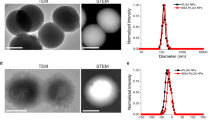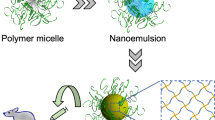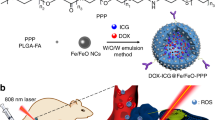Abstract
Polymer-based nanomaterials can deliver antitumor reagents to tumor tissues effectively due to the enhanced permeation and retention (EPR) effect. To further improve the tumor delivery efficacy, a targeting moiety should be installed in the polymer building blocks. In this regard, an acidic pH is one of the characteristics of tumor sites, whereby polymers that respond to acidic conditions would realize the construction of tumor-targeted nanomaterials. In this review, we explain the rationale strategies for the design of functional polymers with responsiveness to a low tumor pH and describe examples of smart nanomaterials designed for selective tumor delivery.
This is a preview of subscription content, access via your institution
Access options
Subscribe to this journal
Receive 12 print issues and online access
$259.00 per year
only $21.58 per issue
Buy this article
- Purchase on Springer Link
- Instant access to full article PDF
Prices may be subject to local taxes which are calculated during checkout






Similar content being viewed by others
References
Kataoka K, Harada A, Nagasaki Y. Block copolymer micelles for drug delivery: design, characterization and biological significance. Adv Drug Deliv Rev. 2001;47:113–31.
Lächelt U, Wagner E. Nucleic acid therapeutics using polyplexes: a journey of 50 years (and beyond). Chem Rev. 2015;115:11043–78.
Boix-Montesinos P, Soriano-Teruel PM, Armiñán A, Orzáez M, Vicent MJ. The past, present, and future of breast cancer models for nanomedicine development. Adv Drug Deliv Rev. 2021;173:306–30.
Klibanov AL, Maruyama K, Torchilin VP, Huang L. Amphipathic polyethyleneglycols effectively prolong the circulation time of liposomes. FEBS Lett. 1990;268:235–7.
Knop K, Hoogenboom R, Fischer D, Schubert US. Poly(ethylene glycol) in drug delivery: pros and cons as well as potential alternatives. Angew Chem Int Ed. 2010;49:6288–308.
Cabral H, Miyata K, Osada K, Kataoka K. Block copolymer micelles in nanomedicine applications. Chem Rev. 2018;118:6844–92.
Matsumura Y, Maeda H. A new concept for macromolecular therapeutics in cancer chemotherapy: mechanism of tumoritropic accumulation of proteins and the antitumor agent Smancs. Cancer Res. 1986;46:6387–92.
Gerlowski LE, Jain RK. Microvascular permeability of normal and neoplastic tissues. Microvasc Res. 1986;31:288–305.
Maeda H. The 35th anniversary of the discovery of EPR effect: a new wave of nanomedicines for tumor-targeted drug delivery-personal remarks and future prospects. J Pers Med. 2021;11:229.
Yamada N, Honda Y, Takemoto H, Nomoto T, Matsui M, Tomoda K, et al. Engineering tumour cell-binding synthetic polymers with sensing dense transporters associated with aberrant glutamine metabolism. Sci Rep. 2017;7:6077.
Mi P. Stimuli-responsive nanocarriers for drug delivery, tumor imaging, therapy and theranostics. Theranostics. 2020;10:4557–88.
Woythe L, Tito NB, Albertazzi L. A quantitative view on multivalent nanomedicine targeting. Adv Drug Deliv Rev. 2021;169:1–21.
de Valk KS, Deken MM, Handgraaf HJM, Bhairosingh SS, Bijlstra OD, van Esdonk MJ, et al. First-in-human assessment of cRGD-ZW800-1, a Zwitterionic, integrin-targeted, near-infrared fluorescent peptide in colon carcinoma. Clin Cancer Res. 2020;26:3990–8.
Thomas A, Teicher BA, Hassan R. Antibody-drug conjugates for cancer therapy. Lancet Oncol. 2016;17:e254–62.
Chau CH, Steeg PS, Figg WD. Antibody-drug conjugates for cancer. Lancet. 2019;394:793–804.
Tew KD. Glutathione-associated enzymes in anticancer drug resistance. Cancer Res. 1994;54:4313–20.
Helmlinger G, Yuan F, Dellian M, Jain RK. Interstitial pH and pO2 gradients in solid tumors in vivo: high-resolution measurements reveal a lack of correlation. Nat Med. 1997;3:177–82.
Huang CH, Takemoto H, Nomoto T, Tomoda K, Matsui M, Nishiyama N. Utility of the 2-nitrobenzenesulfonamide group as a chemical linker for enhanced extracellular stability and cytosolic cleavage in siRNA-conjugated polymer systems. ChemMedChem. 2017;12:19–22.
Gatenby RA, Gillies RJ. Why do cancers have high aerobic glycolysis? Nat Rev Cancer. 2004;4:891–9.
Jain RK, Stylianopoulos T. Delivering nanomedicine to solid tumors. Nat Rev Clin Oncol. 2010;7:653–64.
Wang Y, Zhou K, Huang G, Hensley C, Huang X, Ma X, et al. A nanoparticle-based strategy for the imaging of a broad range of tumours by nonlinear amplification of microenvironment signals. Nat Mater. 2014;13:204–12.
Takemoto H, Nishiyama N. Functional polymer-based siRNA delivery carrier that recognizes site-specific biosignals. J Control Release. 2017;267:90–9.
Cardone RA, Casavola V, Reshkin SJ. The role of disturbed pH dynamics and the Na+/H+ exchanger in metastasis. Nat Rev Cancer. 2005;5:786–95.
Duncan R, Ringsdorf H, Satchi-Fainaro R. Polymer therapeutics–polymers as drugs, drug and protein conjugates and gene delivery systems: past, present and future opportunities. J Drug Taget. 2006;14:337–41.
Kopeček J. Polymer-drug conjugates: origins, progress to date and future directions. Adv Drug Deliv Rev. 2013;65:49–59.
Mura S, Nicolas J, Couvreur P. Stimuli-responsive nanocarriers for drug delivery. Nat Mater. 2013;12:991–1003.
Kinoh H, Quader S, Shibasaki H, Liu X, Maity A, Yamasoba T, et al. Translational nanomedicine boosts anti-PD1 therapy to eradicate orthotopic PTEN-negative glioblastoma. ACS Nano. 2020;14:10127–40.
Wang C, Ge Q, Ting D, Nguyen D, Shen HR, Chen J, et al. Molecularly engineered poly(ortho ester) microspheres for enhanced delivery of DNA vaccines. Nat Mater. 2004;3:190–6.
Tockary TA, Osada K, Motoda Y, Hiki S, Chen Q, Takeda KM, et al. Rod-to-globule transition of pDNA/PEG-poly(l-Lysine) polyplex micelles induced by a collapsed balance between DNA rigidity and PEG crowdedness. Small 2016;12:1193–200.
Rozema DB, Ekena K, Lewis DL, Loomis AG, Wolff JA. Endosomolysis by masking of a membrane-active agent (EMMA) for cytoplasmic release of macromolecules. Bioconjugate Chem. 2003;14:51–7.
Du JZ, Li HJ, Wang J. Tumor-acidity-cleavable maleic acid amide (TACMAA): a powerful tool for designing smart nanoparticles to overcome delivery barriers in cancer nanomedicine. Acc Chem Res. 2018;51:2848–56.
Dixon HB, Perham RN. Reversible blocking of amino groups with citraconic anhydride. Biochem J. 1968;109:312–4.
Maeda Y, Pittella F, Nomoto T, Takemoto H, Nishiyama N, Miyata K, et al. Fine-tuning of charge-conversion polymer structure for efficient endosomal escape of siRNA-loaded calcium phosphate hybrid micelles. Macromol Rapid Commun. 2014;35:1211–5.
Tangsangasaksri M, Takemoto H, Naito M, Maeda Y, Sueyoshi D, Kim HJ, et al. siRNA-Loaded polyion complex micelle decorated with charge-conversional polymer tuned to undergo stepwise response to intra-tumoral and intra-endosomal pHs for exerting enhanced RNAi efficacy. Biomacromolecules. 2016;17:246–55.
Fattal E, Fay F. Nanomedicine-based delivery strategies for nucleic acid gene inhibitors in inflammatory diseases. Adv Drug Deliv Rev. 2021;175:113809.
Sato Y, Nakamura T, Yamada Y, Harashima H. The nanomedicine rush: new strategies for unmet medical needs based on innovative nano DDS. J Control Release. 2021;330:305–16.
Luzio JP, Pryor PR, Bright NA. Lysosomes: fusion and function. Nat Rev Mol Cell Biol. 2007;8:622–32.
Doherty GJ, McMahon HT. Mechanisms of endocytosis. Annu Rev Biochem. 2009;78:857–902.
Xu E, Saltzman WM, Piotrowski-Daspit AS. Escaping the endosome: assessing cellular trafficking mechanisms of non-viral vehicles. J Control Release. 2021;335:465–80.
Miyata K, Oba M, Nakanishi M, Fukushima S, Yamasaki Y, Koyama H, et al. Polyplexes from poly(aspartamide) bearing 1,2-diaminoethane side chains induce pH-selective, endosomal membrane destabilization with amplified transfection and negligible cytotoxicity. J Am Chem Soc. 2008;130:16287–94.
Takemoto H, Miyata K, Nishiyama N, Kataoka K. Bioresponsive polymer-based nucleic acid carriers. Adv Genet. 2014;88:289–323.
Rozema DB, Lewis DL, Wakefield DH, Wong SC, Klein JJ, Roesch PL, et al. Dynamic PolyConjugates for targeted in vivo delivery of siRNA to hepatocytes. Proc Natl Acad Sci U S A. 2007;104:12982–7.
Takemoto H, Miyata K, Hattori S, Ishii T, Suma T, Uchida S, et al. Acidic pH-responsive siRNA conjugate for reversible carrier stability and accelerated endosomal escape with reduced IFNα-associated immune response. Angew Chem Int Ed. 2013;52:6218–21.
Sun CY, Shen S, Xu CF, Li HJ, Liu Y, Cao ZT, et al. Tumor acidity-sensitive polymeric vector for active targeted siRNA delivery. J Am Chem Soc. 2015;137:15217–24.
Zhou K, Wang Y, Huang X, Luby-Phelps K, Sumer BD, Gao J. Tunable, ultrasensitive pH-responsive nanoparticles targeting specific endocytic organelles in living cells. Angew Chem Int Ed. 2011;50:6109–14.
Bikram M, Ahn CH, Chae SY, Lee M, Yockman JW, Kim SW. Biodegradable poly(ethylene glycol)-co-poly(l-lysine)-g-histidine multiblock copolymers for nonviral gene delivery. Macromolecules. 2004;37:1903–16.
Yang Y, Xu L, Zhu W, Feng L, Liu J, Chen Q, et al. One-pot synthesis of pH-responsive charge-switchable PEGylated nanoscale coordination polymers for improved cancer therapy. Biomaterials. 2018;156:121–33.
Li HJ, Du JZ, Liu J, Du XJ, Shen S, Zhu YH, et al. Smart superstructures with ultrahigh pH-sensitivity for targeting acidic tumor microenvironment: instantaneous size switching and improved tumor penetration. ACS Nano. 2016;10:6753–61.
Ke W, Lu N, Japir AAMM, Zhou Q, Xi L, Wang Y, et al. Length effect of stimuli-responsive block copolymer prodrug filomicelles on drug delivery efficiency. J Control Release. 2020;318:67–77.
Sundaram HS, Ella-Menye JR, Brault ND, Shao Q, Jiang S. Reversibly switchable polymer with cationic/zwitterionic/anionic behavior through synergistic protonation and deprotonation. Chem Sci. 2014;5:200–5.
Ranneh AH, Takemoto H, Sakuma S, Awaad A, Nomoto T, Mochida Y, et al. An ethylenediamine-based switch to render the polyzwitterion cationic at tumorous pH for effective tumor accumulation of coated nanomaterials. Angew Chem Int Ed. 2018;57:5057–61.
Miyata K, Nishiyama N, Kataoka K. Rational design of smart supramolecular assemblies for gene delivery: chemical challenges in the creation of artificial viruses. Chem Soc Rev. 2012;41:2562–74.
Corte DD, Schläpfer CW, Daul C. A density functional theory study of the conformational properties of 1,2-ethanediamine: protonation and solvent effects. Theor Chem Acc. 2000;105:39–45.
Gao H, Takemoto H, Chen Q, Naito M, Uchida H, Liu X, et al. Regulated protonation of polyaspartamide derivatives bearing repeated aminoethylene side chains for efficient intracellular siRNA delivery with minimal cytotoxicity. Chem Commun. 2015;51:3158–61.
Kitano H, Sudo K, Ichikawa K, Ide M, Ishihara K. Raman spectroscopic study on the structure of water in aqueous polyelectrolyte solutions. J Phys Chem B. 2000;104:11425–9.
Schlenoff JB. Zwitteration: coating surfaces with zwitterionic functionality to reduce nonspecific adsorption. Langmuir. 2014;30:9625–36.
Shao Q, Jiang S. Molecular understanding and design of zwitterionic materials. Adv Mater. 2015;27:15–26.
Higaki Y, Inutsuka Y, Sakamaki T, Terayama Y, Takenaka A, Higaki K, et al. Effect of charged group spacer length on hydration state in Zwitterionic poly(sulfobetaine) brushes. Langmuir. 2017;33:8404–12.
Kim HJ, Kim A, Miyata K, Kataoka K. Recent progress in development of siRNA delivery vehicles for cancer therapy. Adv Drug Deliv Rev. 2016;104:61–77.
Matsumura Y. Barriers to antibody therapy in solid tumors, and their solutions. Cancer Sci. 2021. https://doi.org/10.1111/cas.14983.
Döhner H, Wei AH, Löwenberg B. Towards precision medicine for AML. Nat Rev Clin Oncol. 2021. https://doi.org/10.1038/s41571-021-00509-w.
Mi P, Kokuryo D, Cabral H, Wu H, Terada Y, Saga T, et al. A pH-activatable nanoparticle with signal-amplification capabilities for non-invasive imaging of tumour malignancy. Nat Nanotech. 2016;11:724–30.
Tang Y, Xiao G, Shen Z, Zhuang C, Xie Y, Zhang X, et al. Noninvasive detection of extracellular pH in human benign and malignant liver tumors using CEST MRI. Front Oncol. 2020;10:578985.
von Knebel Doeberitz N, Maksimovic S, Loi L, Paech D. Chemical exchange saturation transfer (CEST): magnetic resonance imaging in diagnostic oncology. Radiologe. 2021;61:43–51.
Suh J, Paik HJ, Hwang BK. Ionization of poly(ethylenimine) and poly(allylamine) at various pH′s. Bioorg Chem. 1994;22:318–27.
Acknowledgements
This work was financially supported by the Project for Cancer Research and Therapeutic Evolution (P-CREATE) (JP20 cm0106202) from the Japanese Agency for Medical Research and Development (AMED), Technology Platform Program for Advanced Biological Medicine (JP20am0401018) from AMED, Center of Innovation (COI) program from Japan Science and Technology Agency (JST), Five-star Alliance from the Ministry of Education, Culture, Sports, Science and Technology (MEXT), JSPS KAKENHI Grant-in-Aid for Young Scientists (A) (17H04743) to HT from JSPS, and by JSPS KAKENHI Grant Numbers 18H04163 to NN from JSPS.
Author information
Authors and Affiliations
Contributions
HT and NN wrote this manuscript.
Corresponding author
Ethics declarations
Conflict of interest
The authors declare no competing financial interest.
Additional information
Publisher’s note Springer Nature remains neutral with regard to jurisdictional claims in published maps and institutional affiliations.
Rights and permissions
About this article
Cite this article
Takemoto, H., Nishiyama, N. Construction of nanomaterials based on pH-responsive polymers for effective tumor delivery. Polym J 53, 1353–1360 (2021). https://doi.org/10.1038/s41428-021-00542-7
Received:
Revised:
Accepted:
Published:
Issue Date:
DOI: https://doi.org/10.1038/s41428-021-00542-7



